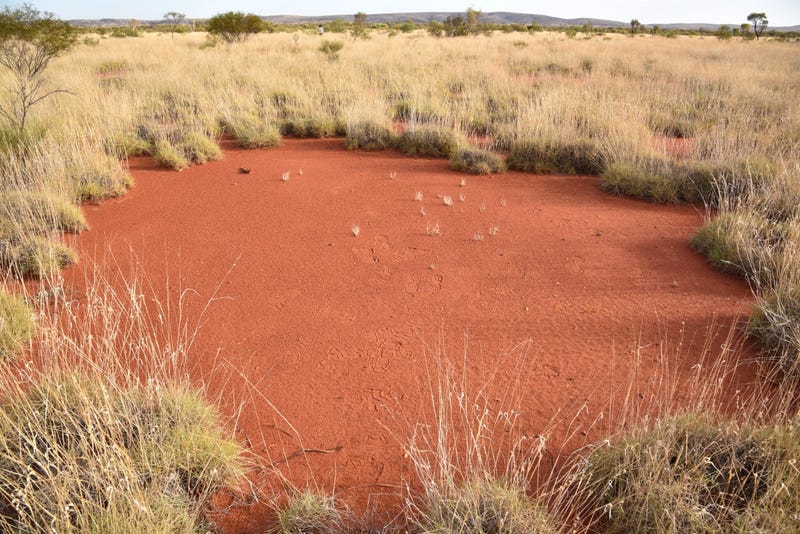No its not where Aquascoot and other phonies cavort. It appears to be plants organizing themselves for survival in water deprived environments.
 http://gizmodo.com/mysterious-fairy-circles-discovered-in-australia-s-ou-1764985... Quote:
http://gizmodo.com/mysterious-fairy-circles-discovered-in-australia-s-ou-1764985... Quote:Mysterious ‘Fairy Circles’ Discovered In Australia’s Outback
Mysterious ‘Fairy Circles’ Discovered In Australia’s Outback
Fairy circles in Australia near Newman. Image: Kevin Sanders
Uniformly spaced gaps called “fairy circles” often appear in the grasslands of Namibia. The unprecedented discovery of these enigmatic patches in the Australian outback now reaffirms an ongoing theory about their origin. (It’s not aliens.)
Fairy circles are circular patches of land, measuring anywhere from between seven to 50 feet (2 to 15 meters) in diameter. They’re exceptionally rare, having only been spotted in the grasslands of Namibia in southwest Africa. But the chance discovery of these mysterious features near Newman in Western Australia suggests it’s a natural phenomenon that’s not exclusive to one particular place on Earth. This latest study on fairy circles now appears in the Proceedings of the National Academy of Sciences.
Mysterious ‘Fairy Circles’ Discovered In Australia’s Outback
Two years ago, lead author Stephan Getzin from the Helmholtz Centre for Environmental Research was contacted by Australian environmental scientist Bronwyn Bell. She had taken photographs from the air showing features consistent with fairy circles. Closer examination confirmed them as being bona fide fairy circles, the first to ever be discovered outside of Namibia.
These patches have been known for years, but no one took the time to actually go out and measure them. What’s more, they’re only really visible from the air, where they collectively appear as uniformly spaced gaps, sometimes in a hexagonal shape. But when seen from the surface, they look like just an ordinary dry patch.
Several theories have been posited to explain these patterned vegetation gaps. One hypothesis suggests the circles are formed by underground bubbles of carbon monoxide that rise up and kill the vegetation on the surface. Some believe they’re caused by ants and termites who are nibbling at the roots of plants.
But the latest study suggests that the gaps are caused by plants who organize themselves based on the amount of water available. Getzin actually came up with this theory a couple of years ago, but the new discovery strengthens his hypothesis. The amount of water available at the transition points between deserts and grasslands aren’t enough to sustain continuous vegetation cover— so the plants are forced to compete for water, and organize themselves accordingly, forming the distinct pattern.
“The interesting thing about fairy circles is that they are spread with great regularity and homogeneity, even over vast areas, but they occur only within a narrow rainfall belt,” noted Getzin in a news release. He said the characteristic honeycomb shape probably results from competition for water. To back this claim, he and his colleagues replicated the effect using computer simulations.
Prior to the new study, skeptics complained about Getzin’s theory, arguing that fairy circles should appear in locations other than Namibia where conditions are similar. The presence of fairy circles in Australia suggests it’s a true natural phenomenon that can repeat elsewhere under similar conditions.
“In Namibia, the sandy soils of the fairy circles are much more permeable and precipitation can drain away with ease,” said Getzin. This causes reservoirs to form under the barren areas, supplying the grass with moisture. “The details of this mechanism are different to that in Australia. But it produces the same vegetation pattern because both systems of gaps are triggered by the same instability.”
What’s particularly exciting about this study is the realization that there may be other unknown natural processes still waiting to be discovered. Getzin’s research shows there’s still lots to learn about our remarkable planet.

 Forum
Forum

 Home
Home 

 Album
Album 

 Help
Help

 Search
Search

 Recent
Recent 

 Rules
Rules 

 Login
Login

 Register
Register





 Pages: 1
Pages: 1

